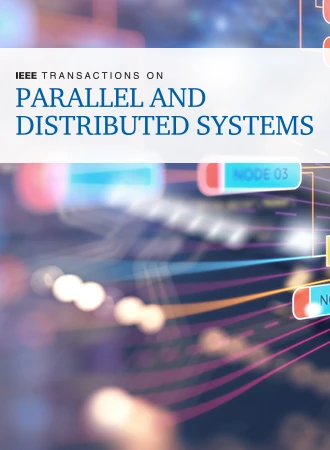利用 CREW 实现高效的跨云部分还原
IF 5.6
2区 计算机科学
Q1 COMPUTER SCIENCE, THEORY & METHODS
IEEE Transactions on Parallel and Distributed Systems
Pub Date : 2024-09-13
DOI:10.1109/TPDS.2024.3460185
引用次数: 0
摘要
部分还原是全部还原的一种很有前途的部分异步变体,它允许 n 个工作者中的 $p$ 在一轮同步中在他们之间进行所有还原操作,在减轻迭代式分布式机器学习(DML)中滞后者的影响方面显示出了它的威力。目前的部分还原解决方案主要是针对集群内的 DML 而设计的,在集群内,工作人员通过高带宽局域网链接联网。然而,对于如何在跨云 DML 中实现高效的部分还原这一问题,此前还没有任何研究成果,因为在跨云 DML 中,工人之间的连接几乎没有可用的容量。为了填补这一空白,我们在本文中提出了 CREW,一种灵活高效的跨云 DML 部分还原实现方法。在高层,CREW 采用了新颖的设计,即利用所有活跃的工作者及其内部连接能力来执行相关的通信和计算任务;在底层,CREW 采用了一套算法,以负载均衡的方式在工作者之间分配任务,并处理工作者/连接可能出现的中断和带宽争用问题。详细的性能研究证实,与全对全直接通信方案和原始的部分还原设计相比,CREW 不仅缩短了每个部分还原操作的执行时间,大大优于现有的通信方案,如 PS、Ring、TopoAdopt 和 BLINK,而且还显著加快了大型模型的训练速度,分别达到 $15/times$ 和 $9/times$。本文章由计算机程序翻译,如有差异,请以英文原文为准。
Efficient Cross-Cloud Partial Reduce With CREW
By allowing
$p$ $n$ $15\times$ $9\times$
求助全文
通过发布文献求助,成功后即可免费获取论文全文。
去求助
来源期刊

IEEE Transactions on Parallel and Distributed Systems
工程技术-工程:电子与电气
CiteScore
11.00
自引率
9.40%
发文量
281
审稿时长
5.6 months
期刊介绍:
IEEE Transactions on Parallel and Distributed Systems (TPDS) is published monthly. It publishes a range of papers, comments on previously published papers, and survey articles that deal with the parallel and distributed systems research areas of current importance to our readers. Particular areas of interest include, but are not limited to:
a) Parallel and distributed algorithms, focusing on topics such as: models of computation; numerical, combinatorial, and data-intensive parallel algorithms, scalability of algorithms and data structures for parallel and distributed systems, communication and synchronization protocols, network algorithms, scheduling, and load balancing.
b) Applications of parallel and distributed computing, including computational and data-enabled science and engineering, big data applications, parallel crowd sourcing, large-scale social network analysis, management of big data, cloud and grid computing, scientific and biomedical applications, mobile computing, and cyber-physical systems.
c) Parallel and distributed architectures, including architectures for instruction-level and thread-level parallelism; design, analysis, implementation, fault resilience and performance measurements of multiple-processor systems; multicore processors, heterogeneous many-core systems; petascale and exascale systems designs; novel big data architectures; special purpose architectures, including graphics processors, signal processors, network processors, media accelerators, and other special purpose processors and accelerators; impact of technology on architecture; network and interconnect architectures; parallel I/O and storage systems; architecture of the memory hierarchy; power-efficient and green computing architectures; dependable architectures; and performance modeling and evaluation.
d) Parallel and distributed software, including parallel and multicore programming languages and compilers, runtime systems, operating systems, Internet computing and web services, resource management including green computing, middleware for grids, clouds, and data centers, libraries, performance modeling and evaluation, parallel programming paradigms, and programming environments and tools.
 求助内容:
求助内容: 应助结果提醒方式:
应助结果提醒方式:


